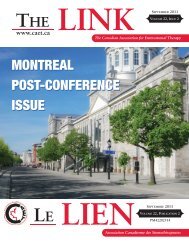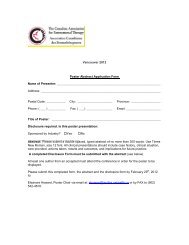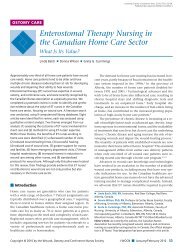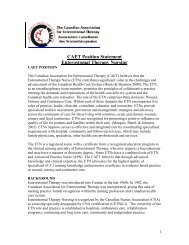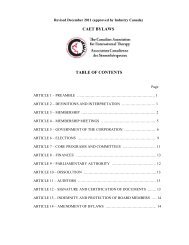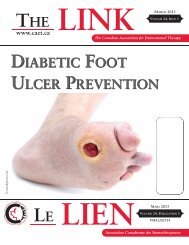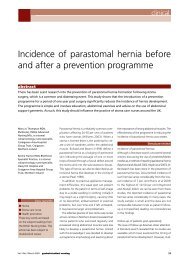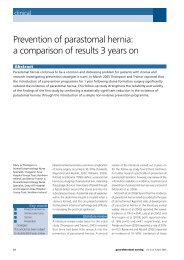Parastomal hernia: incidence, prevention and treatment strategies
Parastomal hernia: incidence, prevention and treatment strategies
Parastomal hernia: incidence, prevention and treatment strategies
You also want an ePaper? Increase the reach of your titles
YUMPU automatically turns print PDFs into web optimized ePapers that Google loves.
Table 3. How to undertake a <strong>prevention</strong> programme study<br />
The study focuses on <strong>prevention</strong> <strong>strategies</strong> for parastomal <strong>hernia</strong> <strong>and</strong> recommends patients undertake a <strong>prevention</strong> programme<br />
based on the premise of strong abdominal muscles reducing the risk of development. This involves advising about <strong>prevention</strong> of<br />
parastomal <strong>hernia</strong>, teaching abdominal exercises to be carried out for 1 year <strong>and</strong> advising the wearing of support garments for<br />
heavy work or heavy lifting in the first year after surgery. It is a combination of these <strong>treatment</strong> modalities that reduces <strong>incidence</strong><br />
of parastomal <strong>hernia</strong> formation.<br />
Steps to take to organize the study:<br />
1. Seek ethical apprpoval (if required) from your Trust<br />
2. A retrospective study of patients operated on in your hospital over a 1-year period who need to have had their surgery at least<br />
1 year ago or else you need to monitor them for 1 year. This is to look at the <strong>incidence</strong> of parastomal <strong>hernia</strong> development prior<br />
to the programme. Assessment can be carried out via computed topography, ultrasound or abdominal assessment.<br />
3. Pick a start date <strong>and</strong> carry out for 1 year a prospective study using the <strong>prevention</strong> programme (see Table 1)<br />
4. On discharge, advise patients of the importance to avoid heavy lifting stressing the consequences being the development<br />
of a parastomal <strong>hernia</strong> <strong>and</strong> advise of an optimal body mass index of 20–25. If necessary refer to the dietician for dietary advice<br />
5. Teach (yourself or the physiotherapist) abdominal exercises outlined in the article from as early as discharge or when the wound<br />
is completely healed. Advise patients of the importance of NOT undertaking a full sit-up as this raises the intra-abdominal<br />
pressure too much <strong>and</strong> may cause a <strong>hernia</strong> – exercises need to be gentle.<br />
6. Teach the importance of maintaining good posture<br />
7. If patients will be undertaking heavy work or lifting after 3 months postoperatively, measure <strong>and</strong> fit for a support garment (any type)<br />
<strong>and</strong> instruct them to wear the garment while undertaking heavy work<br />
8. Regularly review the patients in the prospective arm of the study for 1 year postoperatively, recording any <strong>incidence</strong><br />
of parastomal <strong>hernia</strong><br />
9. Compare the results from both arms of the study<br />
10. Test differences using Chi-squared to record if statistical significance is present.<br />
It is important to remember that surgical technique plays a very important factor <strong>and</strong> will differ from centre to centre, but what<br />
should not differ is the per cent of reduction following the introduction of the programme from your retrospective arm <strong>and</strong> your<br />
prospective arm <strong>and</strong> this should reinforce the use of the programme in <strong>prevention</strong> of parastomal <strong>hernia</strong>.<br />
this is clearly demonstrated by the literature on <strong>incidence</strong> of<br />
<strong>hernia</strong>. If centres do adopt a <strong>prevention</strong> programme, what<br />
should not differ is the per cent of reduction following the<br />
introduction of the programme from the retrospective arm<br />
<strong>and</strong> the prospective arm, <strong>and</strong> this should reinforce the use of<br />
the programme in <strong>prevention</strong> of parastomal <strong>hernia</strong>.<br />
It is essential that <strong>prevention</strong> <strong>strategies</strong> are a significant<br />
aspect of a stoma care nurse’s role to provide care <strong>and</strong> advice<br />
in <strong>prevention</strong> of parastomal <strong>hernia</strong>s.<br />
BJN<br />
Armstrong E (2001) Practical aspects of stoma care. Nurs Times 97(12): 40–2<br />
Arumugam PG, Bevan L, Macdonald L et al (2003) A prospective audit of<br />
stomas – analysis of risk factors <strong>and</strong> complications <strong>and</strong> their management.<br />
Colorectal Dis 5(1): 49–52<br />
KEY POINTS<br />
■ <strong>Parastomal</strong> <strong>hernia</strong> continues to carry significant morbidity for any patient<br />
who has undergone the formation of an abdominal stoma<br />
■ Prevention of parastomal <strong>hernia</strong> should be actively pursued with patients<br />
by stoma care nurses.<br />
■ Stoma care nurses play a pivotal role in educating <strong>and</strong> supporting patients<br />
in minimizing the risk of parastomal <strong>hernia</strong> development.<br />
■ Surgical technique plays a major factor in parastomal <strong>hernia</strong> development.<br />
■ Further research into management <strong>strategies</strong> for parastomal <strong>hernia</strong> repair<br />
is required.<br />
Baig M, Larach J, Chang S et al (2003) Outcome of parastomal <strong>hernia</strong> repair<br />
with relocation without laparotomy: a new technique. Colorectal Dis<br />
5(Suppl 1): 35–80<br />
Blackley P (1998) Practical Stoma, Wound <strong>and</strong> Continence Management. Research<br />
Publications, Australia<br />
Bucknall TE, Cox PJ, Ellis H (1982) Burst abdomen <strong>and</strong> incisional <strong>hernia</strong>:<br />
a prospective study of 1129 major laparotomies. Br Med J (Clin Res Ed)<br />
284(6320): 931–3<br />
Bucknall T, Ellis H (1984) Wound Healing for Surgeons. Baillière Tindall, East Sussex<br />
Carne PW, Robertson GM, Frizelle FA (2003) <strong>Parastomal</strong> <strong>hernia</strong>. Br J Surg<br />
90(7): 784–93<br />
Everingham L (1998) The parastomal <strong>hernia</strong> dilemma. World Council of<br />
Enterostomal Therapists Journal 18(4): 32–4<br />
Harris D, Egbeare D, Benjamin H, Jones S, Foster ME (2003) Analysis of stomas<br />
<strong>and</strong> their complications in a ten year period in a district hospital. Colorectal<br />
Dis 5(Suppl 1): 69<br />
Kane M, McErlean D, McGrogan M, Thompson MJ, Haughey S (2004) Clinical<br />
protocols for stoma care: 6. Management of parastomal <strong>hernia</strong>. Nurs St<strong>and</strong><br />
18(19): 43–4<br />
Lala A, Hamilton J, Daniel T (2002) Audit of stoma care services in a District<br />
General Hospital. Colorectal Dis 4(Suppl 1): 63<br />
Martin L, Foster G (1996) <strong>Parastomal</strong> <strong>hernia</strong>. Ann R Coll Surg Engl 78(2): 81–4<br />
McCahon S (1999) Faecal stomas. In: Porrett T, Daniel N, eds. Essential<br />
Coloproctology for Nurses. Whurr Publishers, London<br />
McGrath A, Porrett T, Heyman B (2006) <strong>Parastomal</strong> <strong>hernia</strong>: an exploration of<br />
the risk factors <strong>and</strong> the implications. B J Nurs 15(6): 317–21<br />
Pearl RK (1989) <strong>Parastomal</strong> <strong>hernia</strong>s. World J Surg 13(5): 569–72<br />
Pringle W, Swan E (2001) Continuing care after discharge from hospital for<br />
stoma patients. Br J Nurs 10(19): 1275–80<br />
Raymond T, Abulafi A (2002) <strong>Parastomal</strong> <strong>hernia</strong> repair: a novel approach.<br />
Colorectal Disease 4(Suppl 1): 64<br />
Rolstad B, Boarini N (1996) Principles <strong>and</strong> techniques in the use of convexity.<br />
Ostomy Wound Manage 42(1): 24–6, 28–32<br />
Rubin MS (2004) <strong>Parastomal</strong> <strong>hernia</strong>s. In: Cataldo PA, MacKeigan JM, eds.<br />
Intestinal Stomas: Principles, Techniques <strong>and</strong> Management. 2nd edn. Marcel<br />
Dekker Inc, New York<br />
Sjodahl R, Anderberg B, Bolin T (1988) <strong>Parastomal</strong> <strong>hernia</strong> in relation to site of<br />
the abdominal wall. Br J Surg 75: 339–341<br />
Thompson MJ, Trainor B (2005) Incidence of parastomal <strong>hernia</strong> before <strong>and</strong><br />
after a <strong>prevention</strong> programme. Gastrointestinal Nursing 3(2): 23–7<br />
Thompson MJ, Trainor B (2007) Prevention of parastomal <strong>hernia</strong>: a comparison<br />
of results 3 years on. Gastrointestinal Nursing 5(3): 22–8<br />
Williams J (2003) <strong>Parastomal</strong> <strong>hernia</strong>. ia Journal 181 Autumn: 14–16<br />
S20 British Journal of Nursing, 2008 (STOMA CARE SUPPLEMENT), Vol 17, No 2



